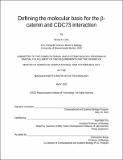Defining the molecular basis for the β-catenin and CDC73 interaction
Author(s)
Lima, Bruna R.
DownloadThesis PDF (5.243Mb)
Advisor
Vos, Seychelle
Terms of use
Metadata
Show full item recordAbstract
RNA polymerase II (Pol II) is required for expression of protein coding genes. To initiate gene transcription, Pol II is recruited to gene promoters by transcription factors. Gene specific transcription factors, including β-catenin, a component of the Wnt signaling pathway, are used to regulate gene expression in response to developmental or environmental cues. Previous studies reported that β-catenin binds to the central region of CDC73, a subunit of the Polymerase Associated Factor 1 complex (PAF). PAF associates with Pol II during transcription elongation to stimulate processive elongation and co-transcriptional histone modification. Genetic studies have shown that CDC73 is required for expression of Wnt signaling pathway genes. In addition, such studies have hypothesized that the interaction between β-catenin and CDC73 was used to recruit Pol II to genes through PAF. In this work I explored how the CDC73•β-catenin interaction is used to regulate gene expression. My data indicates that CDC73 uses its middle region to associate with either PAF or β-catenin but cannot associate with both proteins simultaneously. Both CDC73 and β-catenin weakly interact with nucleic acids meaning that this complex might need another protein factor to mediate their interaction with DNA. To solve the structure of the β-catenin•CDC73 complex, purification strategies require some optimization to isolate a stable complex. Solving the structure of β-catenin•CDC73 complex will define the exact nature of their interaction. Moreover, it will allow for cellular studies of β-catenin•CDC73 and PAF to understand if the complexes are differentially used to regulate gene expression. Together, the work presented in this thesis provide new insights on the β-catenin•CDC73 interaction in comparison with the interaction of CDC73 with PAF.
Date issued
2022-05Department
Massachusetts Institute of Technology. Computational and Systems Biology ProgramPublisher
Massachusetts Institute of Technology